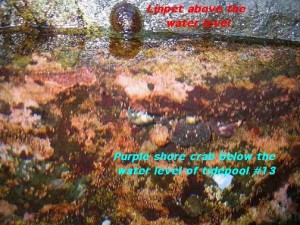 Introduction: In this file, we show the process of identifying vertical structure, the results from some measurements and guidelines on how to conduct an inquiry into vertical structure of an ecosystem.
Introduction: In this file, we show the process of identifying vertical structure, the results from some measurements and guidelines on how to conduct an inquiry into vertical structure of an ecosystem.
Objectives: After doing this lab, you will be able to:
a) Analyze how vertical stratification in your own ecosystem produces a number of different micro-habitats, and predict the effect of this stratification on organisms.
b) Determine which abiotic or biotic factors influence vertical stratification in ecosystems.
c) Design your own protocol for analyzing the effects of vertical structure on ecosystems.
Procedure:
1. Since Race Rocks has no trees,you may not think that the vertical distribution of the ecosystem is very important. Here elevation is a major feature however, as it determines perches for safe lookouts for birds and spaces to haul out for the marine mammals so that they are out of the range of waves and rough sea conditions.
For instance, the favorite perch of the peregrine falcon is on the FM antennae at the top of the tower. Between October and December, in the mornings you may be able to find one perched here by checking on the robotic camera 5.
2. Go to this file with the dichotomous key for help in identification of birds and mammals.
3. Down on the ground where grasses and other vegetation exists, or in and around tidepools, there is vertical stratification even though the complete profile is only several centimeters in height. On Race Rocks, even the profile of the rocks has an effect of changing temperatures and humidity. See this lab done by students, showing the stratification of abiotic factors in tidepools. Describe in your own words what abiotic factors influence the distribution of organisms in tidepools.
4.Not only abiotic factors, but of course biotic factors also have a role in determining the vertical structure of ecosystems. In this picture taken on the West side of Race Rocks at a very low tide, you can see how the pulled back overhanging canopy of the green surfgrass Phyllospadix, creates the shelter necessary for a variety of invertebrate species. Go here for other intertidal images from this area.
5. Vertical profiles in the Ocean, with a Zooplankton Aquatic Profiler can model this.
6. Remember that an ecosystem may also extend below the ground level, so that temperature and water moisture levels are important factors influencing the distribution of species. We will soon add a file here that supports this idea.
7. Now that you may have a better idea how to look for the effects of vertical structure on ecosystems, design your own protocol for analyzing the effect that vertical stratification has on the abiotic factors affecting a species of an ecosystem you can study locally.
Return to the Assignment on Ecosystem Structure and Function
Return to the OceanQuest Index
